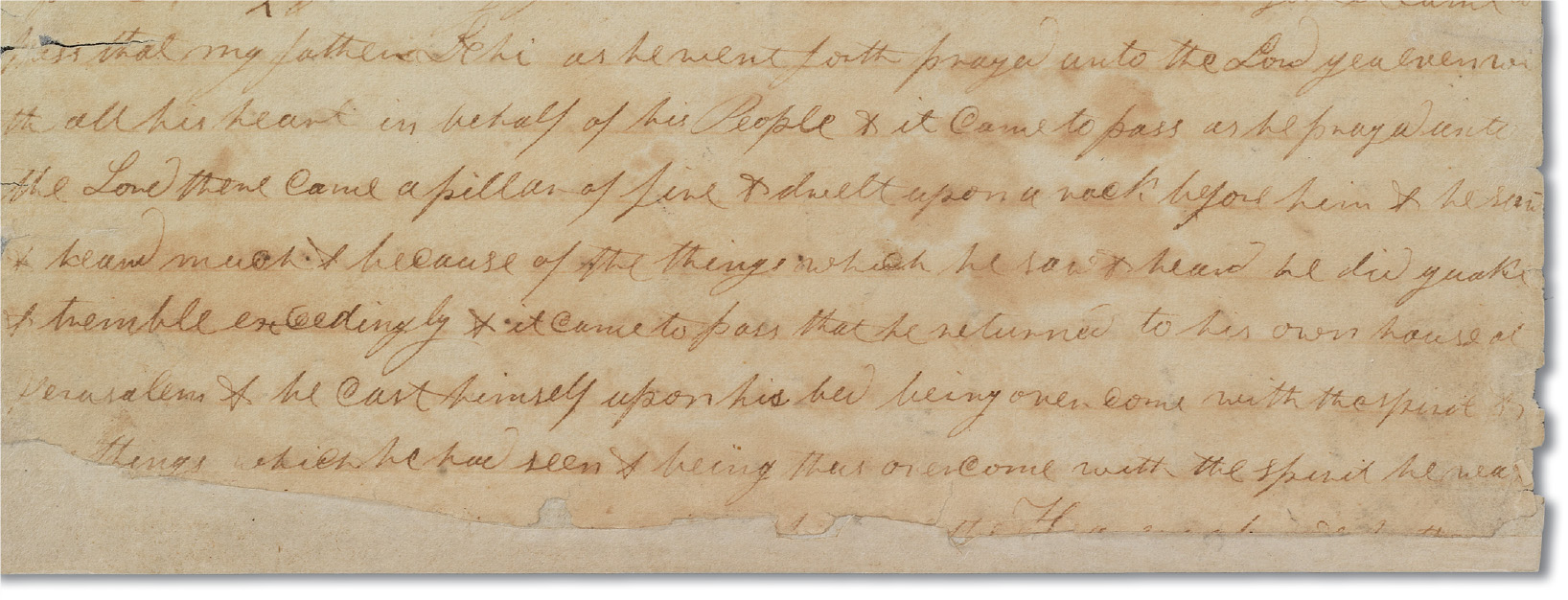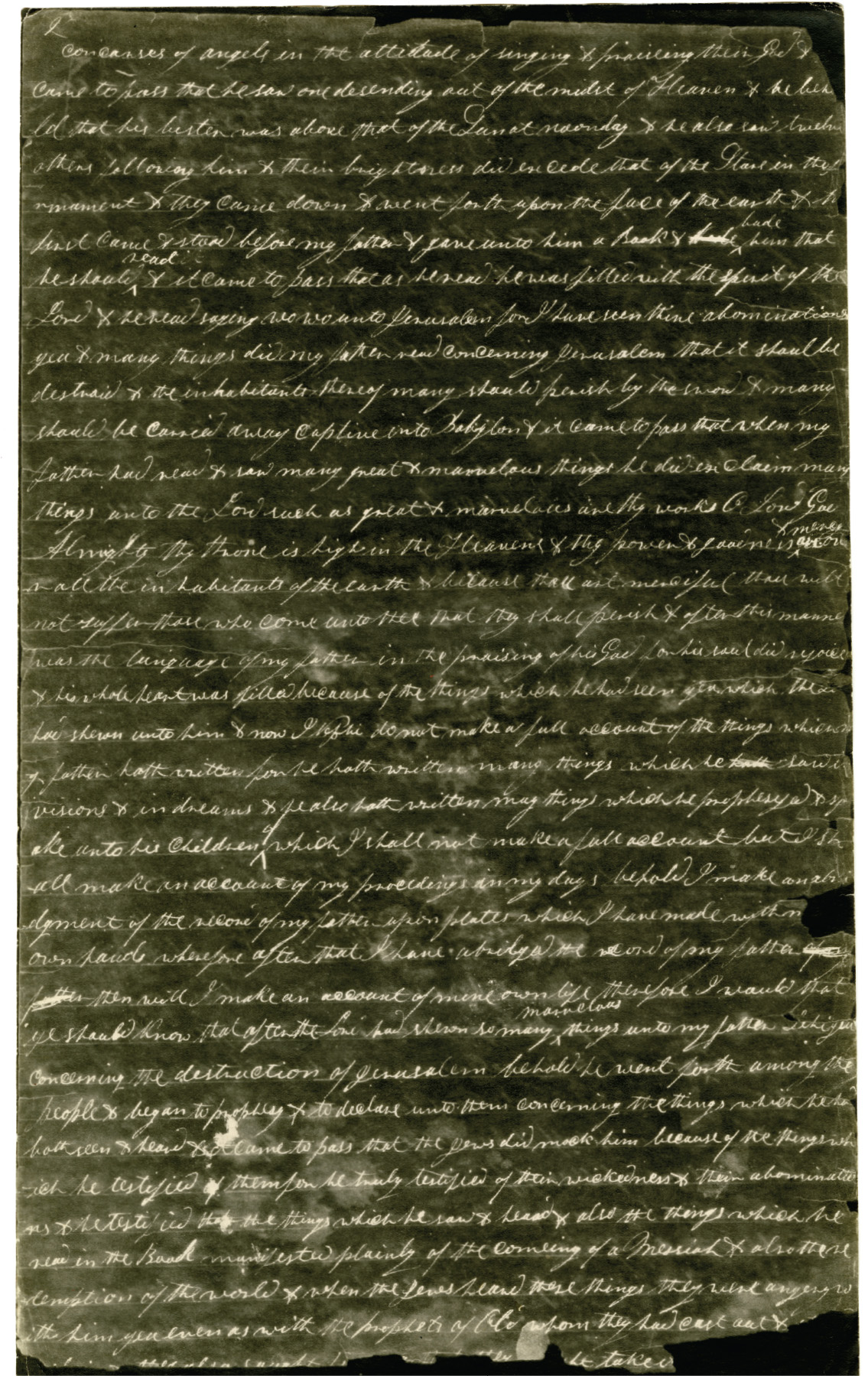Note on Photographic Facsimiles, Printer’s Manuscript of the Book of Mormon
No
matter the care put into transcribing a text, a gap still remains
between the reader and the physical document. The use of
photographic facsimiles in this volume narrows that gap but does not
eliminate it. This note explains how these photographs were created
and prepared for publication and identifies some of their
limitations.
Creating the Photographs
The textual photographs herein were created
specifically for this publication and its online counterpart by
Welden C. Andersen, a lead photographer for the Publishing Services
Department of The Church of Jesus Christ of Latter-day Saints,
onsite at the Community of Christ Library-Archives in Independence,
Missouri. Andersen used a Hasselblad H3DII-39 multishot camera
equipped with a Hasselblad HC 120mm f4 macro lens. By taking a
sequence of four photographs, this camera captures red, green, and
blue data for every pixel, whereas a single-shot camera records only
one color per pixel. The four-shot technology therefore captures
much more detail. The lens is optimized for extremely close
focusing, allowing for images of documents that can resolve to the
level of individual fibers of the paper. Each of the digital images
produced by the camera comprises approximately 229 megabytes of
information. Though the resolution of these images must be reduced
significantly for print publication, the Community of Christ
Library-Archives retains full-resolution files. A copy of these
digital images is also retained by the Joseph Smith Papers
Project.
In 1997, the printer’s manuscript of the Book of Mormon
was encapsulated in Mylar for preservation purposes. For fear of
inadvertently damaging the manuscript, archivists and historians
from the Community of Christ and the Church History Library decided
not to remove the manuscript from the Mylar when it was photographed
for this book in 2012. During photography, the manuscript was
positioned on a low, leveled black table. Studio lights and a fabric
screen were used to illuminate the subject, and a computer was
attached to the camera to process and store the images. To minimize
the reflection of the lights on the Mylar, Andersen placed black
cardstock around the lens of the camera. The camera was positioned
about four feet above the table on a camera stand. Andersen
hand-focused each photograph and then remotely triggered the
shutter. After ensuring the quality of the first image on the
computer monitor, he made a second exposure to create a security
backup copy for each image.
Andersen followed standard professional procedures to
achieve the highest accuracy in color, tone, contrast, and exposure.
Before photographing and any time he adjusted lighting, exposure, or
document angle, he calibrated and corrected color using a color test
card and color adjustment software. This eliminated any bias of the
camera sensor and the light source, meaning that the colors captured
in the photographs are as close as possible to the colors of the
document as it exists today.
Preparing the Photographs for Print
Publication
Charles M. Baird, a prepress specialist with the
Publishing Services Department of The Church of Jesus Christ of
Latter-day Saints, prepared the images for printing. Following
standard prepress methods, Baird reduced the images to fit the page
size in this volume at a resolution of approximately 300 dpi and
converted the images from the color format stored by the camera
(red, green, and blue) to the colors used in printing (cyan,
magenta, yellow, and black).
As mentioned earlier in this note, the documents
featured in this volume were photographed resting on a black table.
For aesthetic reasons, Baird used photo-editing software to
digitally remove the table and the edges of the Mylar from the
background and to add a thin shadow at the bottom of the images.
Baird also digitally removed the Japanese paper that exists at the
edges of some of the manuscript pages; this paper was attached to
the manuscript pages during earlier conservation to prevent further
wear and tear to the edges of the paper.
Except as described in this note, the textual
photographs in this volume have not been altered.
Limitations of the
Photographs
Even careful photographs can underplay important
features of the original document. Two categories of such features
are worth noting here.
First, some details described in the annotation of this
volume can be seen in the original document and in the electronic
images but are too small to be seen well, if at all, in the
photographs printed herein (see figure 1).
Second, certain physical features obscure text of the
original document. For example, the first leaf of the printer’s manuscript has been worn
along the bottom edge, resulting in curling or inward folding of
small portions of the page. This leaf has since been reinforced with
paper backing, which obscures the text of the bottom line (see
figure 2). For this and other instances of worn edges, older
photographs have been consulted, including a series of photographs
of the manuscript taken in 1923 by E. Hobson Tordoff, a member of
the Reorganized Church of Jesus Christ of Latter Day Saints, when he
was conserving the manuscript (see figure 3). These early-twentieth-century
images
are available on the Joseph Smith Papers website,
josephsmithpapers.org.

Fig. 1. This uninked vertical
mark found on manuscript page 63 (between the words “endured” and “the” on the
third line of this image) is similar to other marks found throughout
the manuscript. These marks usually indicated ends of lines or pages
in the 1830 edition and probably helped the compositor mark his
place as he was setting the type.

Fig. 2. The bottom edge of page 1 of the printer’s manuscript has worn away over the
years. At some point, paper backing was affixed to the edge in order
to stabilize the page and prevent further deterioration.

Fig. 3. This negative-image
photograph taken in 1923 shows what a page of the printer’s
manuscript looked like almost one hundred years ago, before backing
was added to the bottom edge of the page. Other pages throughout the
manuscript also show signs of damage. By consulting with the 1923
photographs, the editors of this volume have been able to recover
some of the text. The complete set of 1923
images is available on the Joseph Smith Papers
website.